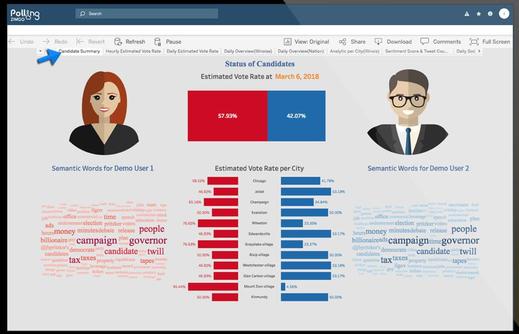|
So, the NLP Fundamentals video I made recently is online as of today (you can find it on the Safari site). Note that since Natural Language Processing is a very broad subject, it is quite hard to do it justice in a single video. However, for someone needing a good introduction to it, this video should be fine. Enjoy!
0 Comments
A few months ago, I wrote a blog post on Artificial Emotional Intelligence, a kind of A.I. that emulates the EQ aspects of our mental process. Of course this technology is still limited to emulating basic aspects of the human emotional spectrum, focusing mainly on comprehending emotion through text data. Nevertheless, this can still add a lot of value to an organization, as in the case of ZimGo Polling, an initiative to predict the outcome of an election, prior to the counting of the votes. BPU Holdings, the company behind this ambitious yet quite down-to-earth initiative, make use of an advanced NLP system, employing some specialized AI systems (interestingly I’m currently in the process of creating a video on the topic of NLP, for Safari!). Also, the data for this endeavor stems from social media, something that ensures abundance as well as freshness, both key factors in making good predictions on this sort of trends. Since part of my job at DSP Ltd. is being up-to-date on the latest and greatest trends in data science and A.I., when a representative of BPU Holdings approached me with their AEI ideas, I took the opportunity to learn more about this field and about what they were doing. That’s how that previous blog post I mentioned came about. Last month, I had the opportunity to talk to the people of this company directly, learning more about their work and AEI’s promise of bringing more value to organizations around the world, through this intriguing niche. After looking into this matter a bit, I became convinced that this company may be actually on to something. The case study presented to me involved the S. Korean elections, where this AEI system managed to predict the results with impressive accuracy. Of course, the company doesn’t plan to rest at its laurels, as there are already plans to apply this new approach to data analytics to other areas, such as the US elections. You can read more about this as well as the company’s offerings in the attached press release as well as its website. Note that I am not affiliated with this company, so if I appear a bit biased towards it that’s because I favor the use of A.I. for such initiatives, rather than other, more aggressive applications, such as those in the military. After all, if there is one thing that I hope has come across from all my postings on this topic, it is that A.I. can be a positive tech, bringing about value to everyone, not just some multinational conglomerates that may not always use it wisely. Also, instead of following blindly this or the other A.I. expert on the social media, I prefer to take a more active approach to this matter by directly connecting with the people involved and providing them with feedback on this tech, as they are developing it. That’s why this blog is the first one worldwide to publicly announce this company’s initiative and bring AEI to the conversation table. What are your thoughts / emotions on it? Feel free to share them with me, either through this blog or via a direct message.
Even though this topic may be a bit polarizing, especially among people who are new to data science, knowing more about it can be very useful, particularly if you value a sense of perspective more than a good grade in some data science crash course. The latter is bound to overemphasize either Stats or AI, depending on the instructor's knowledge and experience. However, some data science professionals, myself included, prefer a more balanced approach on the topic. This is the reason why I decided to make this video, which is now available on Safari for your viewing. Note that this is by no means a complete tutorial on the topic, but it is a good overview of the various aspects of statistics related to data science, along with some programming resources in both Python and Julia, to get you started. Enjoy! Recently I decided to spice things up a bit and experiment with a new, more fresh approach to videos. As a result, I played around with graphics more, in an effort to go for a more intuitive presentation of the topic I looked at, namely sampling (check out the video here). Not all videos that ensue are going to be like that, but I’m definitely going to look into more interesting ways of tackling the graphics part. This kind of video production takes a lot of work though and as I haven’t done graphics design in years, I’m a bit rusty and such a project takes a considerable amount of time. At the same time, I need to keep promoting my stuff online and one of the strategies I’ve found quite effective is through articles on beBee. As a result, I won’t be posting articles on my blog that often. However, if someone is interested in contributing to it, I’d be happy to consider guest authors on Data Science, A.I., Cyber-security, Programming, and other relevant topics. A.I. and ML are often used interchangeably, while many people consider one to be a subset of the other (which one is the bigger set depends on who you ask). However, things may not be as clear-cut as they may seem, since the communities of these two fields are not all the related, while there is a sort of rivalry among the hard-core members of each one of them. Why is that though if A.I. and ML are so similar to each other, enough to confuse even data scientists? First of all, let’s start with some definitions. A.I. is the group of methods, algorithms, and processes, that bring about computer systems that emulate human intelligence, even if the intelligence they usually exhibit is quite different to our own. Also, these systems often take the form of self-sufficient machines, such as robots, as well as agent programs that roam the Internet or cyber space in general. ML on the other hand is the group of methods, algorithms, and processes that bring about computer systems that solve some data analytics problem in an efficient manner, through some training procedure (the learning part of machine learning). The latter can be with the help of some specific outcomes (aka targets) or without. Also, the training can take the form of feedback on the system’s predictions, which is like on-the-job training of sorts. Clearly, there is a close link between ML and data science, since ML systems are designed for this sort of problems. A.I. systems on the other hand, may tackle different kinds of problems too (e.g. finding the optimal route given some restrictions). So, there is a part of A.I. that is leveraged in data science and a part of A.I. that has nothing to do with our craft. That part of A.I. that is used in data science has a large intersect with ML, mainly through network-based systems, such as ANNs. Lately, Deep Learning networks, which are specialized and more sophisticated kinds of ANNs, have become quite popular and are also part of that intersect between A.I. and ML. Many people who work in A.I. consider it more of a science than ML and they are right in a way. Most of ML methods are heuristics based and don’t have much theory behind them, while the ones that are tied to Stats (Statistical and ML hybrids) are heavily restrained by the assumptions that the Stats theory has. A.I. methods are generally data-driven though, but also related to processes found in nature, so they are not out of the blue. Nevertheless, a data scientist who is being professional and pragmatic doesn’t put too much emphasis on the differences between A.I. and ML methods, since he cares more about how they can be applied to solve the problems at hand. So, even if these two families of methods are not the same, nor is one a subset of the other, they are both very useful, if not essential, in practical data science. |
Zacharias Voulgaris, PhDPassionate data scientist with a foxy approach to technology, particularly related to A.I. Archives
April 2024
Categories
All
|
||||||





 RSS Feed
RSS Feed